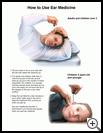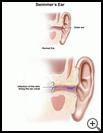
Swimmer's Ear (Outer Ear Infection)
________________________________________________________________________
KEY POINTS
- Swimmer’s ear is an infection of the outer ear and ear canal that can happen when moisture and bacteria or a fungus gets trapped in the ear. A common cause is swimming in dirty water or in untreated water such as a lake or ocean.
- Your healthcare provider will carefully clean and dry your ear. You may need to put antibiotic drops in your ear several times a day.
- Follow the full course of treatment prescribed by your healthcare provider. If you are taking an antibiotic, take the medicine for as long as your healthcare provider prescribes, even if you feel better. Keep water out of your ears until the infection is completely gone.
________________________________________________________________________
What is swimmer’s ear?
Swimmer’s ear is an infection of the outer ear and ear canal. It is also called otitis externa.
What is the cause?
An outer ear infection can happen when moisture and bacteria or a fungus gets trapped in the ear. A common cause of swimmer's ear is swimming in dirty water or in untreated water such as a lake or ocean. Getting water in your ear often, such as frequent swimming or showering, can increase your risk of getting an infection. Other things that increase your risk for swimmer’s ear include:
- Injuring the skin in your ear by using a cotton tipped swab or something sharp to clean your ear canal
- Irritation of the skin in your ear from getting chemicals such as hair spray or hair dye in your ear
- Irritation from wearing hearing aids
- Skin allergies including metal allergies to jewelry
What are the symptoms?
Symptoms may include:
- Itching
- Pain and swelling in the ear canal (moving the outer ear increases the pain)
- Fluid or pus draining from the ear, which may smell bad
- Crusting around the ear opening
Sometimes swelling or pus may decrease your hearing.
How is it diagnosed?
Your healthcare provider will ask about your symptoms and medical history and examine your ears. Your provider may take a sample of pus to be tested in the lab. If you have an infection, it may take several days to find out what kind of germ is causing it. Knowing what germ is causing the infection helps your provider choose the right medicine to treat it.
How is it treated?
Your healthcare provider will carefully clean and dry your ear. You may need to put antibiotic drops in your ear several times a day. If your ear is very swollen, your provider may insert a small piece of cloth (called a wick) into the ear to help get the medicine into the infected area.
Your provider may prescribe an antibiotic that you take by mouth if you have a severe infection.
Your provider may suggest a cream or ointment to put on the infected area for some types of infection.
The pain and swelling will go away gradually as the antibiotics or other medicines take effect. Most outer ear infections clear up completely in 5 to 7 days. Outer ear infections caused by allergies or skin conditions may take longer to heal.
How can I take care of myself?
Follow the full course of treatment prescribed by your healthcare provider. In addition:
- If you are taking an antibiotic, take the medicine for as long as your healthcare provider prescribes, even if you feel better. If you stop taking the medicine too soon, you may not kill all of the bacteria and you may get sick again.
- Keep water out of your ears until the infection is completely gone. Take baths instead of showers. Ask your provider how you should protect your ears when you wash your hair.
Ask your provider:
- How and when you will get your test results
- How long it will take to recover
- If there are activities you should avoid and when you can return to your normal activities
- How to take care of yourself at home, including how to take care of your ear and how to remove the wick
- What symptoms or problems you should watch for and what to do if you have them
Make sure you know when you should come back for a checkup. Keep all appointments for provider visits or tests.
How can I help prevent swimmer’s ear?
- Use a washcloth, not things such as cotton tipped swabs, pencils, or toothpicks to try to clean your ear.
- After your ear is healed, ask your healthcare provider if it might help to wear earplugs or to use something such as lamb's wool to keep your ears dry when you swim and shower.
- Dry your ears carefully if you get water in them.
- Be careful when using chemicals such as hair products in the area around your ear.


